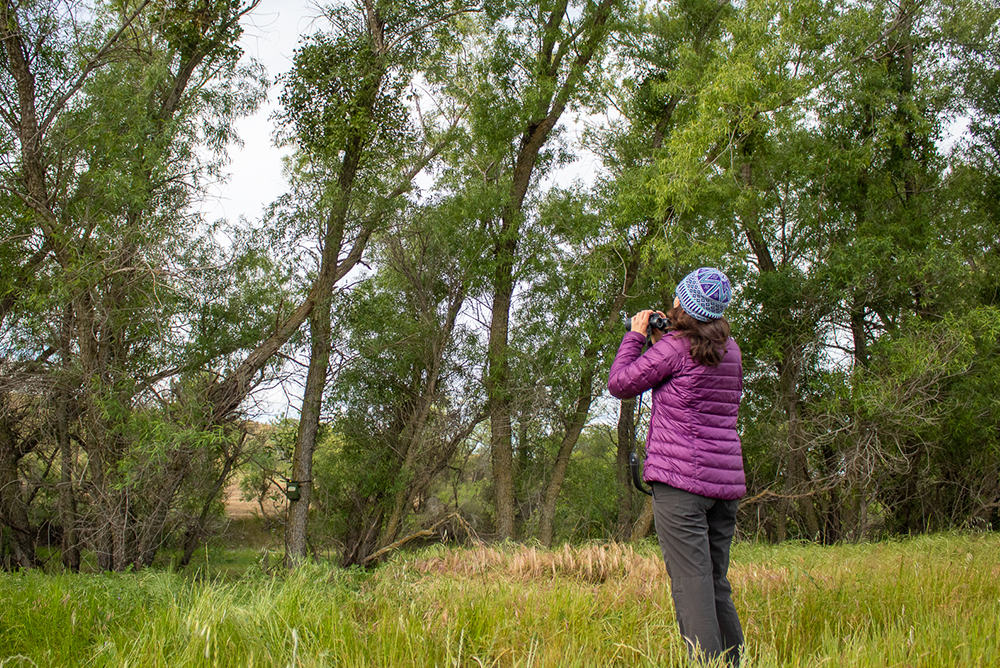BY TIM SCHOMMER
In the hustle and bustle of daily activities on Travis Air Force Base, southwest of Sacramento, a variety of noises can be heard. Aircraft take off and land, vehicles accelerate through installation neighborhoods, power tools buzz and clang in a hangar, and “The Star-Spangled Banner” plays on public loudspeakers at the end of each day.
As humans, we are used to the cacophony of ambient noise that surrounds us daily. But for the birds that share our spaces, those sounds might cause distress, even affect their ability to successfully mate and raise young. As part of the natural resource team on Travis, three CEMML biologists set out to determine how manmade noise affects nesting birds of prey, like owls, hawks, and eagles.
But why is a bird’s sensitivity to noise important to a military base? The answer begins with the Migratory Bird Treaty Act, a conservation law intended to protect migratory bird species from being killed, captured, sold, traded, or transported without prior authorization from the U.S. Fish and Wildlife Service (USFWS). Travis Air Force Base is home to over 100 migratory bird species, including raptors. Some, like the Swainson’s hawk and the white-tailed kite, are protected under state legislation as well as by the Act. Both civilian and military communities must abide by these laws, which can come into play in many circumstances, particularly when planning construction projects.
“Let’s say the base is going to build a new dormitory somewhere and 30 feet away there is a protected bird nesting in a tree. Having data about how noise affects birds would help us determine whether the construction project is going to disturb that bird and change its behavior in a detrimental way. That could be a violation of the Migratory Bird Treaty Act,” said Christopher Reddin, a CEMML wildlife biologist at Travis.
So how do you determine what noise level bothers a bird? “There have been studies done for different noise levels, for example using construction noise, to monitor how these activities affect birds,” said Reddin. “These noises are conducted at different distances and intensities so that you can observe changes in the bird’s behavior such as cowering, making alarm or protest calls, ceasing mating activities, or fleeing the area altogether.” The problem with this approach is that it inevitably involves bothering a bird to determine that threshold.

The biologists found that ambient noise decreased during the pandemic in 2020. They also observed more nesting raptors then compared to 2021, when ambient noise returned to pre-pandemic levels. So, does this mean that more noise leads to fewer nesting raptors? The answer isn’t clear, according to Karen Gallardo, a CEMML wildlife biologist on the team. “Yes, there were more nesting raptors in 2020, but this could have been not just because of noise, but because of the climate or because maybe there was more food availability,” she noted.
The interplay of all these factors makes it difficult to determine a specific distance threshold for not disturbing nesting birds, which was one of the original goals of the noise study. Nonetheless, it’s important to try to understand how human activities impact wildlife. Much of the natural resource team’s work involves conducting surveys, monitoring species, and generally finding ways for the military mission to co-exist with not just birds, but other wildlife too.
Travis hosts four federally protected species, and its natural resources team must ensure that the requirements of all federal regulations are met. CEMML’s experts help military installations strike the right balance, so they can carry out their mission while preserving important species and their habitat.
“The CEMML biologists are my eyes and ears for what’s occurring on the base,” said Leslie Peña, the natural resource team manager at Travis. “Without them noticing uncoordinated projects or checking up on areas, the base could be out of compliance, which could hamper our primary mission. We simply couldn’t do the job without them.”
 CEMML wildlife biologist Dr. Lyndsay Rankin checks a sound recorder near a raptor nesting area at Travis Air Force Base in California.
CREDIT: KAREN GALLARDO, CEMML.
CEMML wildlife biologist Dr. Lyndsay Rankin checks a sound recorder near a raptor nesting area at Travis Air Force Base in California.
CREDIT: KAREN GALLARDO, CEMML.